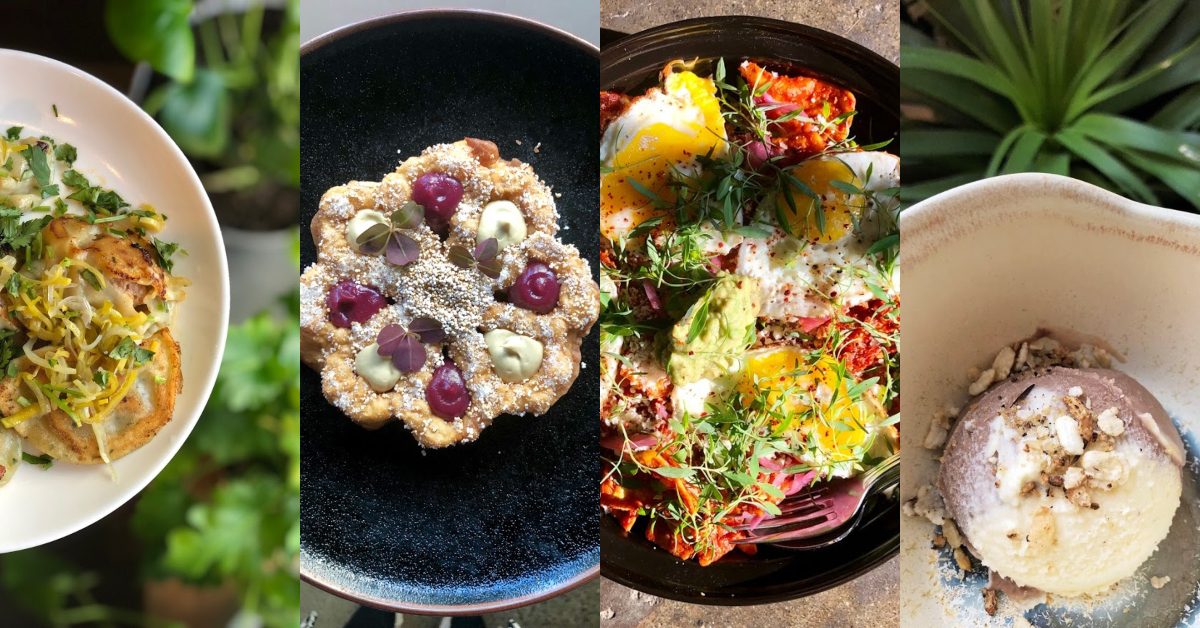This article is a recap of the 2020 StarChefs' Seattle Rising Stars event that took place in February.
When asked about his source of inspiration for cooking during Symrise’s Sponsored Roundtable for StarChefs’ Seattle Rising Star, Chef Ricardo Valdes of El Xolo and Raiz reflected for a moment before talking about his roots in Mexico and declaring that memory creates his “rolodex of flavors.” Regardless of the type of restaurant in which he’s worked, “I’ve constantly remembered the way my Grandmother cooked,” he said, adding that “common threads are the spice of chilies, bold acidity, and the salinity from super-aggressive use of salt.”
PART 1: When “Waste” Creates Great Taste
Valdes noted that people have a reverence for ingredients in other countries, and he is glad to see that starting to happen here in the United States. “My Grandmother took diligent care of her ingredients,” he recalled, and he tries to emulate that. For his chilaquiles, he grinds his own annatto seeds to make achiote paste. Sometimes he experiments with ingredients he thinks will work well together, such as combining fermented habaneros and carrots to make salsa.
Brian Clevenger, Restaurateur and Chef of General Harvest Restaurants, echoed similar thoughts about paying homage to ingredients, lessons learned from travel in Europe. Some ingredients stand out pretty much on their own, he said. He seeks what’s crave-able: things “so good that everyone wants to taste it again.” For example, he gets excited about the seasonality of heirloom tomatoes, wanting to let their beauty shine and showcasing them with just a little salt and oil to bring the flavors out—not cover them up.  Bartender Jennifer Akin of Rumba has traveled to the sources to learn more about rum and to expand the repertoire of drinks at her rum-forward bar. She talked about the “insanely problematic history of rum” revealed when she visited distilleries in places like St. Lucia, which is incredibly poor. Cocktails are not a concept there; instead, people drink rum (usually a cheap version) straight, or maybe spiced rum using natural, locally-grown ingredients. She came across innovative preparations such as spiced rum with horny goat weed and even a marijuana-infused rum. She tries to remember and replicate the flavors that inspire her. In addition to spiced rum, she’s bringing savory elements to drinks, such as miso cocktails and dill or caraway-forward aquavits, plus milk punch with its unexpected lactose element.
Bartender Jennifer Akin of Rumba has traveled to the sources to learn more about rum and to expand the repertoire of drinks at her rum-forward bar. She talked about the “insanely problematic history of rum” revealed when she visited distilleries in places like St. Lucia, which is incredibly poor. Cocktails are not a concept there; instead, people drink rum (usually a cheap version) straight, or maybe spiced rum using natural, locally-grown ingredients. She came across innovative preparations such as spiced rum with horny goat weed and even a marijuana-infused rum. She tries to remember and replicate the flavors that inspire her. In addition to spiced rum, she’s bringing savory elements to drinks, such as miso cocktails and dill or caraway-forward aquavits, plus milk punch with its unexpected lactose element.
Stay ahead of the changing industry with In-sight, learn more here!
Crystal Chiu, Pastry Chef at Canlis, talked about finding inspiration in travel to places like Bali and other parts of Asia. Often, she said, she doesn’t try to recreate dishes because the ingredients are particular to faraway places and what’s available locally “doesn’t do justice to the dish.” Instead, she tries to replicate some of the learned techniques and also find flavor associations. For example, she liked the moisture and tanginess of Indonesian tapai cake that comes from fermented cassava that’s part of the batter, associating it with the use of sour cream in cakes here. She’s also excited by ingredients that are new to her—either in their current form or transformed. “Whatever farmers can produce, I’m excited to use,” she asserted. Her first summer in Seattle, she found herself with an abundance of cherries, so she decided to ferment them to preserve them. “I did a lacto-ferment, burped it, and suddenly the Bing cherries had the taste and aroma of bananas, while the Rainiers had the aroma of grapefruit,” she explained. She used these associations to construct creative desserts for her customers.
She’s also excited by ingredients that are new to her—either in their current form or transformed. “Whatever farmers can produce, I’m excited to use,” she asserted. Her first summer in Seattle, she found herself with an abundance of cherries, so she decided to ferment them to preserve them. “I did a lacto-ferment, burped it, and suddenly the Bing cherries had the taste and aroma of bananas, while the Rainiers had the aroma of grapefruit,” she explained. She used these associations to construct creative desserts for her customers.
For these Rising Stars, the common theme to building a Rolodex of flavors is clearly travel. National and international travel brings exposure to new ingredients and techniques. Local travel to places like specialty farms brings opportunity to develop relationships with farmers and producers to procure quality products—sometimes new. And travel back in time taps into memories and family recipes.
Which brings us back to Valdez, who frequently deploys a technique called tatemado, which means burnt or charred. Inspired by his grandmother in Mexico, he cooks at a comal, burning leek scraps that he’ll then dehydrate, pulverize to powder, and add to something like sour cream for a dipping sauce a la French onion dip. The flavor is delicious, he says, and it comes with a bonus of making his kitchen and his restaurant smell great.
Subscribe to the Weekly In-sight Newsletter to stay in the loop for all things food and beverage!
Images courtesy of Instagram (@rumbaseattle and @chewyfoodlife).





